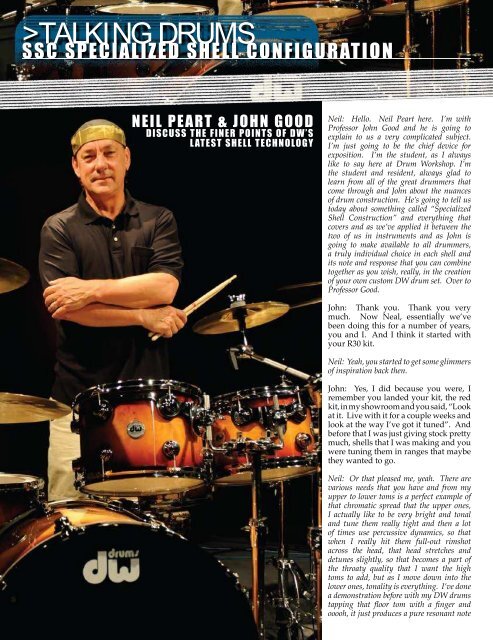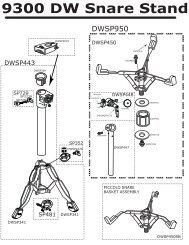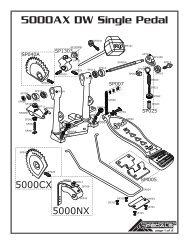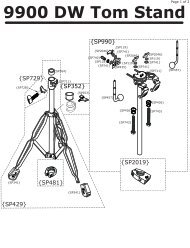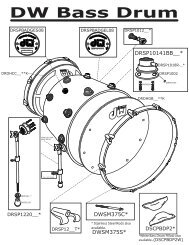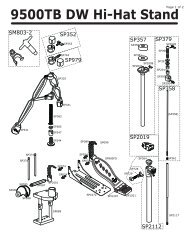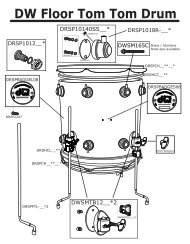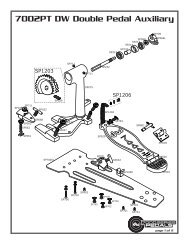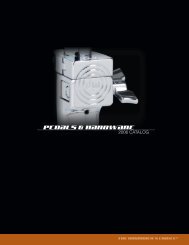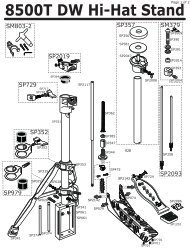Man these feel really really good. - Drum Workshop
Man these feel really really good. - Drum Workshop
Man these feel really really good. - Drum Workshop
You also want an ePaper? Increase the reach of your titles
YUMPU automatically turns print PDFs into web optimized ePapers that Google loves.
TALKING DRUMS<br />
ssc specialized shell coNfiguraTioN<br />
Neil pearT & JohN <strong>good</strong><br />
d i s c u s s T h e f i N e r p o i N T s o f d w ’ s<br />
laTesT shell TechNology<br />
Neil: Hello. Neil Peart here. I’m with<br />
Professor John Good and he is going to<br />
explain to us a very complicated subject.<br />
I’m just going to be the chief device for<br />
exposition. I’m the student, as I always<br />
like to say here at <strong>Drum</strong> <strong>Workshop</strong>. I’m<br />
the student and resident, always glad to<br />
learn from all of the great drummers that<br />
come through and John about the nuances<br />
of drum construction. He’s going to tell us<br />
today about something called “Specialized<br />
Shell Construction” and everything that<br />
covers and as we’ve applied it between the<br />
two of us in instruments and as John is<br />
going to make available to all drummers,<br />
a truly individual choice in each shell and<br />
its note and response that you can combine<br />
together as you wish, <strong>really</strong>, in the creation<br />
of your own custom DW drum set. Over to<br />
Professor Good.<br />
John: Thank you. Thank you very<br />
much. Now Neal, essentially we’ve<br />
been doing this for a number of years,<br />
you and I. And I think it started with<br />
your R30 kit.<br />
Neil: Yeah, you started to get some glimmers<br />
of inspiration back then.<br />
John: Yes, I did because you were, I<br />
remember you landed your kit, the red<br />
kit, in my showroom and you said, “Look<br />
at it. Live with it for a couple weeks and<br />
look at the way I’ve got it tuned”. And<br />
before that I was just giving stock pretty<br />
much, shells that I was making and you<br />
were tuning them in ranges that maybe<br />
they wanted to go.<br />
Neil: Or that pleased me, yeah. There are<br />
various needs that you have and from my<br />
upper to lower toms is a perfect example of<br />
that chromatic spread that the upper ones,<br />
I actually like to be very bright and tonal<br />
and tune them <strong>really</strong> tight and then a lot<br />
of times use percussive dynamics, so that<br />
when I <strong>really</strong> hit them full-out rimshot<br />
across the head, that head stretches and<br />
detunes slightly, so that becomes a part of<br />
the throaty quality that I want the high<br />
toms to add, but as I move down into the<br />
lower ones, tonality is everything. I’ve done<br />
a demonstration before with my DW drums<br />
tapping that floor tom with a finger and<br />
ooooh, it just produces a pure resonant note<br />
with incredible sustain and I love that in<br />
the lower toms for them to have that great<br />
note recognition and quality, so that became<br />
a part of the shell design. It started with<br />
the lower toms, I think, and with the bass<br />
drum, John applying his ideas in creating<br />
tonality by combining the wood grains in<br />
different directions.<br />
John: Well, having said that, I, in the<br />
earlier years of drum shell construction<br />
and making, I always thought it was<br />
the thicker the shell, the higher the<br />
pitch, thinner the shell, lower the pitch<br />
and that’s it.<br />
Neil: Huh…OK, I didn’t even know that.<br />
John: Oh yeah. Well, like cymbals. The<br />
thicker ones have a higher pitch and<br />
the thinner ones have a darker, washier<br />
pitch. So, today we’re going to mess<br />
with that theory entirely.<br />
Neil: I mean investigate that science.<br />
John: And the way we want to start<br />
doing that is I brought three pieces of<br />
veneer here and I’ve drawn some lines<br />
so you can actually see…<br />
Neil: They didn’t grow that way.<br />
John: They didn’t grow this way. It’d<br />
be pretty cool to find a tree that does<br />
that.<br />
Neil: Ha ha ha…But we’re looking.<br />
John: So, I’ve drawn an arrow on the<br />
direction of the grain…to understand<br />
<strong>really</strong> what we’re talking about here,<br />
you <strong>really</strong> need to understand veneer<br />
first and so, I will use you as my<br />
student.<br />
Neil: Hmm.<br />
John: OK, here we have<br />
a piece of 1/36”<br />
veneer and this is very, very thin<br />
obviously, but the grain is running in<br />
the direction. If you hold your hand<br />
out, you will see that it holds itself very<br />
well.<br />
Neil: It keeps its shape.<br />
John: And the grain is running this<br />
direction. Now, every piece of wood<br />
has a musical note value and you’ll<br />
be able to hear this. Tell me if you can<br />
hear it.<br />
Neil: Yeah.<br />
John: There’s a note in there. Ok now,<br />
see the way I’m tapping this, I’m gonna<br />
hold it and I want you to tap it for me.<br />
Neil: Listen...Remarkable.<br />
John: So the pitch went up, right? And<br />
the pitch went up with tension. Now,<br />
<strong>feel</strong> this tension here. That’s a fair<br />
amount of tension.<br />
Neil: It wants to straighten out.<br />
John: It absolutely does. So that’s what<br />
we’re going to call “horizontal grain”.<br />
Then we have another piece here that<br />
is a similar size. If you hold your hand<br />
out, and you notice the grain is going<br />
the opposite direction, it’s going “short<br />
grain”. Hold your hand out, you’ll see<br />
how it just falls.<br />
Neil: Like a piece of wallpaper.<br />
John: Ha ha, basically yes. And it has<br />
a note value as well, but I wouldn’t be<br />
able to change that because I can’t put<br />
any tension on this, so we’re going<br />
to call that “vertical<br />
grain”. Then I<br />
have<br />
this wacky, wild diagonal cut piece of<br />
grain here and if you hold your hand<br />
out, you’ll notice that it twists like this.<br />
Neil: It wants to spiral.<br />
John: Now, if you tap the side while<br />
I try to straighten it out, look what<br />
happens. Tap the side.<br />
Neil: Tap tap tap tap tap tap…it seems<br />
to me an even exaggerated raising of the<br />
pitch.<br />
John: It’s raising the pitch, but it’s<br />
getting its tension from a whole<br />
different place, so we’re going to call<br />
that “diagonal grain”, right? What<br />
does all this mean? Ah…<br />
Neil: Ha ha ha. How can we use it?<br />
John: How can we use it?<br />
Neil: When we hit things with a stick.<br />
John: Which we’ll get into later and is<br />
a very interesting concept. How can<br />
we us it? I have 5 drum shells here and<br />
the first shell is the typical ….the shells<br />
that I love….many years…olive grain<br />
on the outside…on the inside, crosslaminated<br />
in between. It’s a 7-ply shell<br />
with 3-ply reinforcing hoops…one goes<br />
this way, the one behind it goes that<br />
way and then this way…and you have<br />
to have….So that’s a 7+3, 3-ply hoop....<br />
and more at www.dwdrums.com/ssc<br />
[edge 8.0] 15


